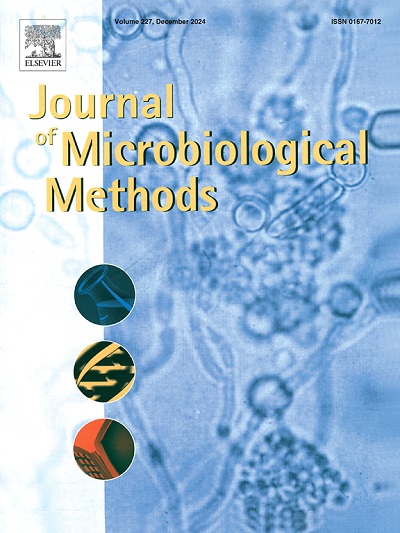结核病爆发诊断工具的未来:以 LAMP 和 RPA 诊断测试为重点的方法综述。
IF 1.9
4区 生物学
Q4 BIOCHEMICAL RESEARCH METHODS
引用次数: 0
摘要
结核病(TB)仍然是由结核分枝杆菌(MTB)引起的世界上最常见的发病和死亡原因。由于诊断和治疗方案进展缓慢,该疾病已成为公共卫生的一大隐患,同时也增加了全球经济的负担。当务之急是通过护理点检测(POCT),以快速、灵敏和便宜的结核病诊断检测来降低结核病的发病率。因此,重组酶聚合酶分析法(RPA)和环介导等温扩增法(LAMP)等分子检测技术在这方面发挥了重要作用,因为它们的工作原理是核酸等温扩增。RPA 和 LAMP 弥补了以往基于 PCR 的检测工具与其他已报道的 MTB 等温工具之间的研究空白。在这篇综述中,我们将努力概述这种检测方法,它将成为一种在自然光下用肉眼快速扩增和观察 DNA 的新方法。事实证明,RPA 和 LAMP 与侧流(LF)试纸条和 SYBR Green I 结合使用是一种高度特异性的病原体检测技术。此外,RPA 和 LAMP 还为满足 POC 诊断结核病的关键要素(如通用药敏试验)铺平了道路。不过,RPA 比 LAMP 更适合 POC 水平,因为它需要较低的扩增温度(约 37-42 °C)和更简单的引物设计。本文章由计算机程序翻译,如有差异,请以英文原文为准。
The future in diagnostic tools for TB outbreaks: A review of the approaches with focus on LAMP and RPA diagnostics tests
Tuberculosis (TB) is still the most frequent cause of morbidity and mortality in the world caused by Mycobacterium tuberculosis (MTB). Due to slow diagnostic and treatment options, the disease is a major concern for public health and also increases the burden on the global economy. Rapid, sensitive, and cheaper TB diagnosis test is urgent to lower their rates by point of care testing (POCT). Therefore, molecular detection techniques like recombinase polymerase assay (RPA) and Loop-mediated isothermal amplification (LAMP) play a significant role in this regard as they work on the principle of isothermal nucleic acid amplification. RPA and LAMP bridge the research gap between the previous PCR-based detection tool and other reported isothermal tools for MTB. In this review, we endeavor to provide an overview of the assay that will be a novel approach toward a rapid amplification and visualization of DNA by the naked eye in natural light. RPA and LAMP can prove to be a highly specific pathogen detection technique in combination with lateral flow (LF) strips and SYBR Green I. Optimization of amplification conditions also made the assay ideally suited to the resource-limited field application at POCT. Additionally, RPA and LAMP have paved the way for meeting a key component of the POC diagnosis of TB like universal drug susceptibility testing. However, RPA is more suitable at the POC level than LPA as it requires a lower amplification temperature of around 37–42 °C and a simpler primer design.
求助全文
通过发布文献求助,成功后即可免费获取论文全文。
去求助
来源期刊

Journal of microbiological methods
生物-生化研究方法
CiteScore
4.30
自引率
4.50%
发文量
151
审稿时长
29 days
期刊介绍:
The Journal of Microbiological Methods publishes scholarly and original articles, notes and review articles. These articles must include novel and/or state-of-the-art methods, or significant improvements to existing methods. Novel and innovative applications of current methods that are validated and useful will also be published. JMM strives for scholarship, innovation and excellence. This demands scientific rigour, the best available methods and technologies, correctly replicated experiments/tests, the inclusion of proper controls, calibrations, and the correct statistical analysis. The presentation of the data must support the interpretation of the method/approach.
All aspects of microbiology are covered, except virology. These include agricultural microbiology, applied and environmental microbiology, bioassays, bioinformatics, biotechnology, biochemical microbiology, clinical microbiology, diagnostics, food monitoring and quality control microbiology, microbial genetics and genomics, geomicrobiology, microbiome methods regardless of habitat, high through-put sequencing methods and analysis, microbial pathogenesis and host responses, metabolomics, metagenomics, metaproteomics, microbial ecology and diversity, microbial physiology, microbial ultra-structure, microscopic and imaging methods, molecular microbiology, mycology, novel mathematical microbiology and modelling, parasitology, plant-microbe interactions, protein markers/profiles, proteomics, pyrosequencing, public health microbiology, radioisotopes applied to microbiology, robotics applied to microbiological methods,rumen microbiology, microbiological methods for space missions and extreme environments, sampling methods and samplers, soil and sediment microbiology, transcriptomics, veterinary microbiology, sero-diagnostics and typing/identification.
 求助内容:
求助内容: 应助结果提醒方式:
应助结果提醒方式:


